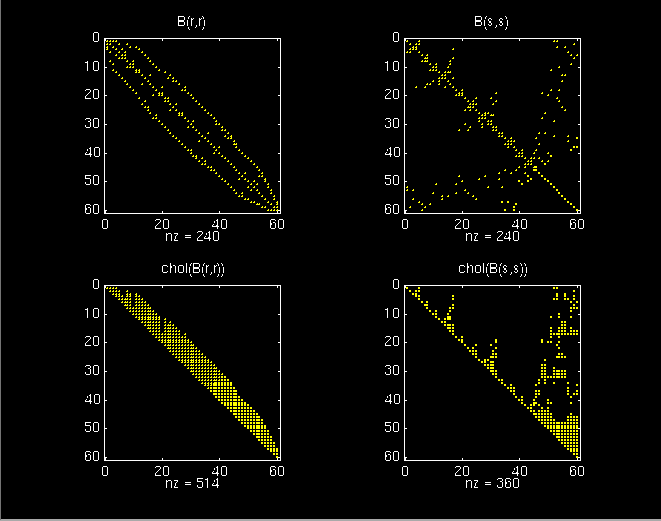Symmetric minimum degree ordering for elimination sparsity.
p = symmmd(S)
p = symmmd(S) returns a symmetric minimum degree ordering of S. For a symmetric positive definite matrix S, this is a permutation p such that S(p,p) tends to have a sparser Cholesky factor than S. Sometimes symmmd works well for symmetric indefinite matrices too.
The minimum degree ordering is automatically used by \ and / for the solution of symmetric, positive definite, sparse linear systems.
Some options and parameters associated with heuristics in the algorithm can be changed with spparms.
The symmetric minimum degree algorithm is based on the column minimum degree algorithm. In fact, symmmd(A) just creates a nonzero structure K such that K'*K has the same nonzero structure as A and then calls the column minimum degree code for K.
Here is a comparison of reverse Cuthill-McKee and minimum degree on the Bucky ball example mentioned in the symrcm reference page.
B = bucky+4*speye(60);
r = symrcm(B);
p = symmmd(B);
R = B(r,r);
S = B(p,p);
subplot(2,2,1), spy(R), title('B(r,r)')
subplot(2,2,2), spy(S), title('B(s,s)')
subplot(2,2,3), spy(chol(R)), title('chol(B(r,r))')
subplot(2,2,4), spy(chol(S)), title('chol(B(s,s))')

\, chol, colmmd, colperm, spparms, symrcm
[1] John R. Gilbert, Cleve Moler, and Robert Schreiber, "Sparse Matrices in MATLAB: Design and Implementation," SIAM Journal on Matrix Analysis and Applications 13, pp. 333-356, 1992.


(c) Copyright 1994 by The MathWorks, Inc.


